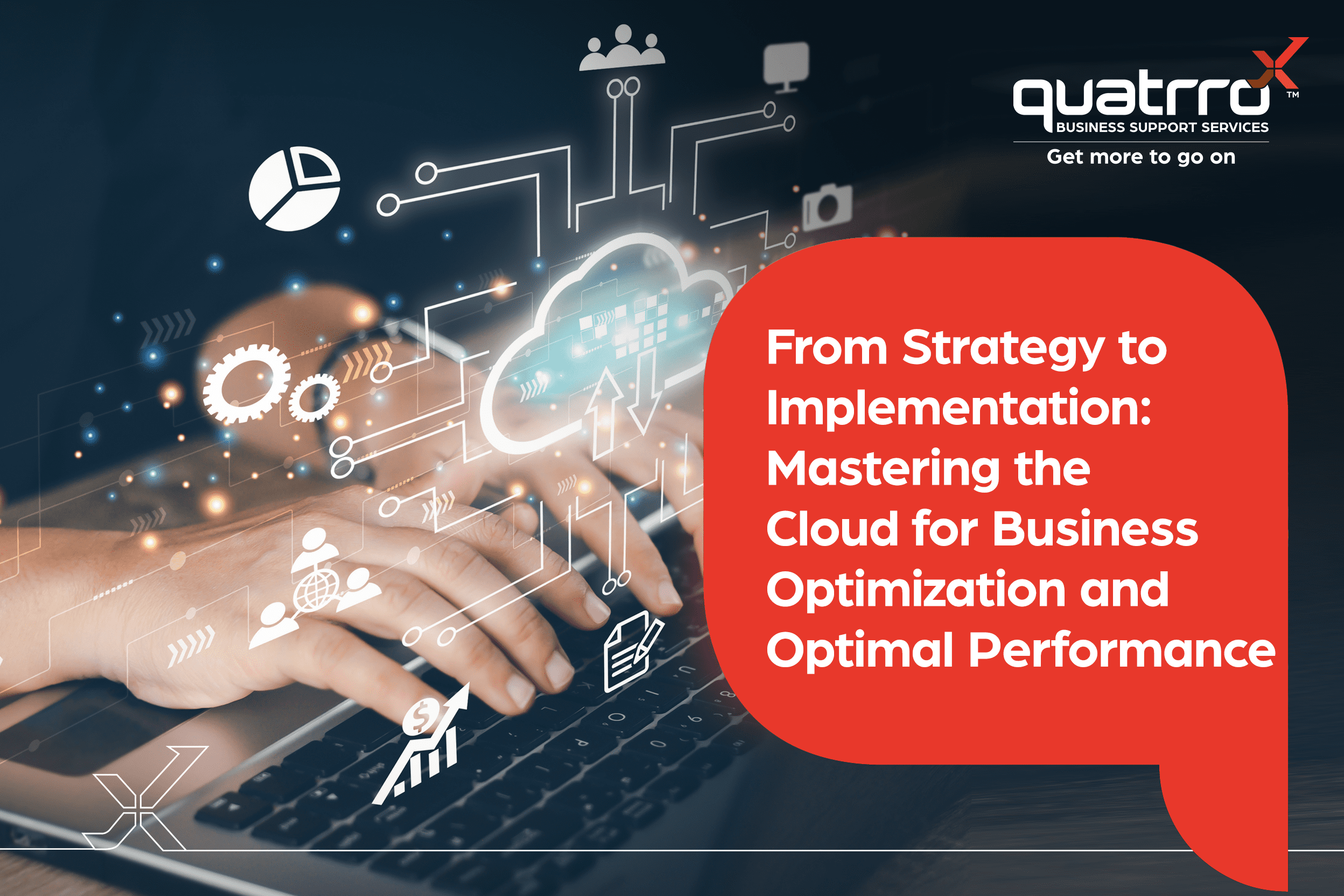Blog Details
From Strategy to Implementation: Mastering the Cloud for Business Optimization and Optimal Performance
December 21, 2023

In today's dynamic and competitive business landscape, agility, scalability, and cost- efficiency are no longer buzzwords but essential for success. Cloud computing has emerged as a disruptive force, enabling businesses to achieve these objectives and unlock their full potential. This strategic guide delves into the intricacies of transitioning to the cloud, navigating through data privacy and compliance concerns, using SaaS solutions, implementing seamless data migration strategies, and optimizing costs for efficient business operations.
Understanding the Why and How: Deciding on the Right Cloud
The journey to the cloud demands a nuanced understanding of its implications in the short and long term. A well-defined strategy and action plan that align with the organization’s objectives are required for a successful transition. Starting with a firm grasp of your business objectives, you can tailor your cloud adoption plan to address specific needs. Whether you want to boost agility to respond quickly to market changes, enhance scalability to accommodate growth bursts or reduce costs to optimize your IT budget, the cloud provides a powerful solution.
Begin by thoroughly evaluating the existing infrastructure and applications to determine which are best suited for relocation. This simplifies the process and lays the groundwork for the smooth integration of cloud services. Identifying the resources that can be seamlessly migrated to the cloud is essential. This initial analysis helps you choose the right cloud service model. Do you require the flexibility and control of infrastructure as a Service (IaaS), the rapid development environment of Platform as a Service (PaaS), or the readily available applications of software as a Service (SaaS)? Choosing the model that best aligns with your needs and resources can ultimately help ensure a smooth and successful transition.
Amidst this transition, prioritizing security is paramount. Encryption protocols, multi-factor authentication, and robust access controls are the bedrock of a secure cloud environment. As organizations navigate this transformative phase, a blend of agility and foresight is crucial to overcome potential hurdles and capitalize on newfound opportunities.
Understanding and Leveraging Cloud Service Models for Enhanced Business Efficiency
Cloud computing has revolutionized the way businesses operate, is offered in three distinct service models: Infrastructure as a Service (IaaS), Platform as a Service (PaaS), and Software as a Service (SaaS). Each model unlocks unique strengths and caters to specific business needs, empowering decision-makers to choose the optimal cloud solution for their business goals.
 |
Fuelling Flexibility and Control: Infrastructure as a Service (IaaS):Imagine crafting your ideal cloud infrastructure, brick by virtual brick. IaaS provides this level of control, allowing you to customize operating systems, software, and configurations for a perfectly tailored environment. This empowers you to:
Navigating IaaS requires technical expertise and ongoing management, which can be difficult for some organizations to handle. If you choose this model, be prepared to invest in skilled IT teams to handle security, configuration, and performance optimization. |
 |
Fast-Track Innovation, Simplify Operations: Platform as a Service (PaaS):offers a pre-configured platform, complete with development tools, runtime environments, and databases, ready to launch your applications. This streamlined approach provides:
PaaS, however, involves a trade-off: limited customization and potential vendor lock- in. Your applications become tied to the platform provider's ecosystem, and extensive customization might not be readily available. This is something to be seriously considered when making your cloud model decision. |
 |
Plug-and-Play Productivity: Software as a Service (SaaS):Ditch lengthy deployments and hefty investments. SaaS delivers pre-configured applications for diverse areas like CRM, HR, and marketing, ready to empower your workforce instantly. This "plug-and-play" approach unlocks a plethora of benefits:
Finding Your Optimal Cloud Solution: The choice between IaaS, PaaS, and SaaS does not have to be just one OR the other. You may also want to consider a hybrid approach that leverages the strengths of each model to create a tailor-made solution for your specific business needs. By understanding each cloud service model's distinct advantages and potential limitations within your organizational structure and goals, you can confidently navigate the cloud landscape and unlock its transformative potential for your business. |
Data Privacy and Compliance: Securely Navigate the Cloud
While the cloud boasts impressive benefits, data privacy and compliance concerns can deter businesses from fully embracing its potential. In the age of increasing data scrutiny, safeguarding sensitive information is non-negotiable. Cloud solutions, when configured correctly, not only meet stringent data protection standards but can also enhance overall security within an organization. Depending on the industry you are in, you may want to emphasize the importance of partnering with cloud service providers well-versed in industry- specific compliance requirements. This section provides a high-level overview of these crucial aspects, equipping you with the knowledge to navigate this complex landscape.
Aligning with Industry Standards: Compliance with industry-specific standards like HIPAA, PCI DSS, and GDPR is imperative for businesses in regulated sectors. Choose a cloud service provider (CSP) committed to security and compliance, offering transparent reports, certifications, and controls aligned with your industry's requirements.
Continuous Monitoring and Reporting: Compliance isn't a one-time effort. Regularly conduct audits and assessments to identify and address potential risks. Implement a reporting framework to demonstrate compliance to auditors and stakeholders through detailed records of activities, security controls, and incident response measures.
Safeguarding Sensitive Data: Robust data encryption, access controls, and user authentication are essential for securing sensitive information. Data loss prevention (DLP) solutions further protect data by monitoring activity and preventing unauthorized transfers. Regularly review and update data security policies to maintain effectiveness.
Incident Response: A well-defined incident response plan outlines roles, responsibilities, communication protocols, and mitigation strategies for addressing breaches and compliance violations. Regularly test your plan through simulations to identify gaps and refine procedures for optimal effectiveness.

Seamless Data Migration: A Key to Cloud Success
A well-planned data migration strategy assures business continuity and reduces disruption during your cloud move. The first step is identifying and categorizing your data based on criticality and sensitivity. This categorization helps you prioritize the migration process and allocate resources effectively.
Choosing the right data migration tools and methodologies is critical for a successful transition. Your data's volume, complexity, and security requirements will determine the most suitable tools and techniques. Developing a robust data migration plan with clearly defined roles, responsibilities, and timelines facilitates a smooth and efficient process.
Thorough testing and data integrity verification are essential before migrating to the cloud. These measures ensure that your data is accurate, complete, and secure throughout the migration process. Finally, implementing robust disaster recovery and backup plans safeguards your data against unforeseen events, minimizing potential disruptions and ensuring business continuity.
Throughout the migration process, communication is paramount. Keep stakeholders informed, manage expectations, and address concerns promptly. Realize that data migration is not merely a technical endeavor but a strategic initiative that demands alignment with business objectives, so should not be executed without all key stakeholders involved. Organizations can seamlessly transition to the cloud by prioritizing this synergy without sacrificing operational continuity.
Optimizing Costs for Maximum Value
While the cloud offers unparalleled scalability, unregulated utilization might result in unanticipated costs. Controlling cloud costs is critical for getting the most out of your investment. To maximize the value proposition of cloud computing, comprehensive cost control measures must be used. Leverage tools for real-time cost monitoring, enabling decision-makers to optimize resources based on usage patterns. You can significantly reduce your cloud spend by right-sizing your cloud resources, eliminating waste, and utilizing cost- saving options offered by CSPs, such as spot instances.
Striking the right balance between performance and cost involves a nuanced understanding of cloud service models. Explore spot instances and on-demand pricing to align expenses with actual usage. Continuous monitoring and optimization should become a perpetual cycle, ensuring that cloud resources evolve with business needs.
Furthermore, implementing cloud automation tools streamlines provisioning, scaling, and resource management, increasing efficiency and reducing costs. Finally, monitoring and analyzing your cloud costs provides valuable insights into usage patterns and helps you identify areas for further optimization.
Embracing Cloud Transformation: A Journey, Not a Destination
In conclusion, unlocking the full potential of the cloud requires a comprehensive strategy and a commitment to continuous improvement and adaptation.
Businesses can position themselves as industry leaders by methodically deciding on the right cloud solution, prioritizing data privacy and compliance, embracing diverse cloud service models (IaaS, PaaS, and SaaS) for efficiency, executing seamless data migration, and optimizing costs. By adopting a strategic and well-planned approach, organizations can leverage the power of this transformative technology to achieve their business goals, enhance operational efficiency, and gain a competitive edge in today's dynamic environment.
Remember, the cloud journey is not a destination but an ongoing process of innovation and optimization. By adopting a forward-thinking mindset and remaining adaptable to change, businesses can maximize the long-term benefits of cloud computing and achieve unprecedented success. This strategic guide serves as a compass, guiding decision-makers toward a future where the cloud becomes not just a technology but a catalyst for unparalleled business success.

